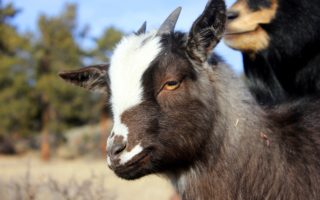Getting a new goat or goats can be very stressful on the animal(s). There’s things you can do to help with the transition while at the same time practicing bio security to keep the rest of your herd safe. I’ve heard some pretty brutal stories of new goats getting seriously injured or killed by the resident goats. This isn’t a frequent occurrence but can happen.

Quarantine
The most important thing you can do is quarantine a new goat(s) for up to 30 days. Ideally, you’ll keep them somewhere that’s separate from your herd but so they can still see the other goats. This means no touching through a fence in case the new goats is carrying any illness that’s transferable to your herd. Goats DO NOT do well all by themselves. If you only have one new goat and aren’t able to keep them within eye shot of your other goats, then it helps to have at least a wether (neutered male) to provide the new goat as a companion. This does put the wether at risk of catching anything the new goat may be carrying. But if the new goat is expensive then it may be worth the risk to make them more comfortable. If you’re able, bathing the new goat would further remove anything transferable, including the dirt in their hooves.
During this time you’ll also want to provide the new goat with the feed they were being fed prior to you purchasing them, and gradually switching them to what you feed. This way the new goat(s) will be ready to eat what your going to be feeding once the join the rest of the herd.
Treat For Parasites
Find out whether or not the goat(s) has been dewormed recently. If they haven’t you’ll want to get that done. I also preen through their coat looking for lice. Whether or not I find any lice, I still apply pure powdered sulfur just in case.
Introducing To The Rest Of The Herd
 Your current goats WILL BE JERKS to your new arrival(s). Your unlikely to have a flawless transition. It’s all about figuring out who’s in charge and establishing the herd hierarchy. This means you will absolutely want to introduce them when you can be around to supervise their interactions. Ideally, you have enough space for the new goat(s) to get out of the way from being butted or pushed around.
Your current goats WILL BE JERKS to your new arrival(s). Your unlikely to have a flawless transition. It’s all about figuring out who’s in charge and establishing the herd hierarchy. This means you will absolutely want to introduce them when you can be around to supervise their interactions. Ideally, you have enough space for the new goat(s) to get out of the way from being butted or pushed around.
Helpful Tips . . .
-Introduce At Feeding Time: If you can get your current goats focused on meal time, then it’ll take the focus off the newbies and give the new comers a chance to investigate their new environment.
-Provide An Extra Feeder: Whether they’re hungry or not, your current goats will likely try to hog and guard the feeder, making it difficult for the new goat(s) to eat. Providing an additional feeder makes it more difficult to monopolize and gives the new goat an alternative feeder to feed at.
-Provide Hiding Spots: This is as simple as obstacles that the goats have to get around over or under in order to chase. In my goat pen, there’s a couple trees, platform, large farm tire, and hay feeder that act as obstacles that the goats have to get around in order to chase one another.
-Horns & No Horns: If you have a mixed flock of horns, disbudded, or polled goats, I personally think this doesn’t make a difference in procedure other than you’ll want to keep and extra close eye on any aggression that takes place. Obviously a goat with horns has the advantage over the one(s) that don’t. If the goat(s) with horns are being especially aggressive you can either grind the points down so they’re less sharp, or cut a couple of pieces from foam noodles to cover the horn tips.
 -Introducing New Buck(s): I would think you keep any buck(s) you have separate from your does until it’s actually breeding season. Putting a buck in with your does is often uneventful. The does don’t often challenge the buck, and run away to avoid his love advances (unless they’re in heat). If you’re buying an additional buck to what you already own, that can be a bit more tricky. I wouldn’t recommend housing bucks together right next to your does as anytime the does go into heat the bucks will battle. If they are equally match then it’s not a super big deal and may in fact act as exercise. BUT! I wouldn’t recommend keeping horned and none horned bucks together unless they are house well away from the girls. They are much more brutal to each other and the buck without horns can get seriously injured.
-Introducing New Buck(s): I would think you keep any buck(s) you have separate from your does until it’s actually breeding season. Putting a buck in with your does is often uneventful. The does don’t often challenge the buck, and run away to avoid his love advances (unless they’re in heat). If you’re buying an additional buck to what you already own, that can be a bit more tricky. I wouldn’t recommend housing bucks together right next to your does as anytime the does go into heat the bucks will battle. If they are equally match then it’s not a super big deal and may in fact act as exercise. BUT! I wouldn’t recommend keeping horned and none horned bucks together unless they are house well away from the girls. They are much more brutal to each other and the buck without horns can get seriously injured.
-Introducing New Baby(ies): I don’t like adding babies to my herd until they’ve reached at least half the size of my does. They’re more equipped to get away and and can take a hit if it happens. Again, provide hiding spaces. For babies, it’s best having something they can get under that the adults can’t.
Conclusion
Once goats figure out who’s in charge and things settle down things should be just fine. Hope you found some of these tips helpful and I wish you all luck on introducing your new arrivals.









